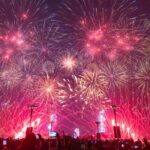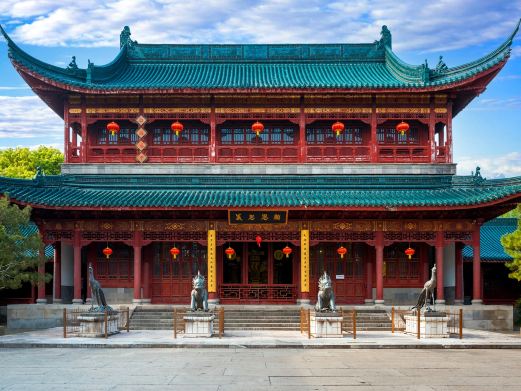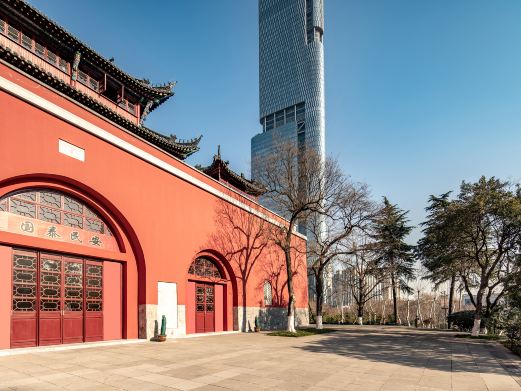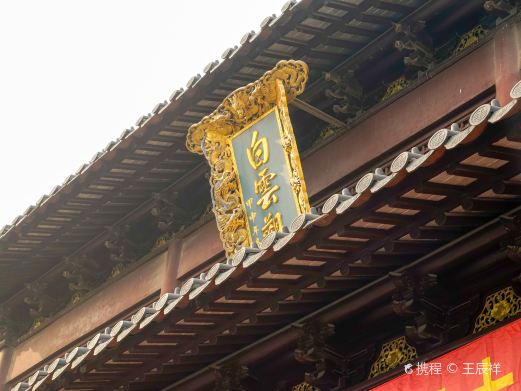Langya Terrace Scenic Area is located on the eastern coast of Langya Town in Huangdao District, renowned for the historical Langya Terrace where Emperor Qin Shi Huang ascended three times, and Xu Fu embarked from here to sail eastward to Japan. Within the area, you can follow the ‘Imperial Path’ once treaded by Qin Shi Huang, climb Langya Terrace to gaze upon the vast sea and feel the emperor’s aspiration for the mythical mountains in the sea.
The scenic area mainly comprises Langya Terrace, Longwan, and the coastal scenic belt around the terrace. The core attraction is Langya Terrace, which features the Langya Culture Exhibition Hall, Xu Fu Temple, Cloud Ladder, Langya Inscriptions, Wangyue Tower, and other scenic spots. The area is not large, and Langya Terrace is not particularly high, with an elevation of only 183.4 meters. Apart from the Cloud Ladder and the Qin Imperial Path, most of the mountain paths are relatively easy to walk.
Entering the scenic area from the West Main Gate (main entrance), you can first visit the Langya Culture Exhibition Hall and Xu Fu Temple. In the exhibition hall, you can learn about the historical changes of the ancient Langya region and the ancient historical figures who once toured Langya, as well as view the cultural relics unearthed from Langya Terrace and ancient literary inscriptions. Xu Fu is a pioneer of friendly interactions between China and Japan, and within Xu Fu Temple, there is a statue of Xu Fu along with detailed paintings depicting his life and his journey to Japan.
The Cloud Ladder is a section of granite steps from Xu Fu Temple leading to the Dragon Viewing Pavilion, originally one of the three imperial paths for Qin Shi Huang to ascend Langya Terrace. The ladder consists of 336 steps, which can be tiring to climb in one go, but there are several platforms in between for resting. The Dragon Viewing Pavilion is a half-mountain antique-style pavilion where you can overlook the Longwan beach to the northeast of Langya Terrace.
Continuing up the mountain, you will encounter the iconic historical site of Langya Terrace—the Qin Dynasty inscriptions. The stele once bore 86 characters written by the Qin Chancellor Li Si, one of the earliest inscriptions in China. However, only fragments of the stele remain and are now housed in the National Museum. The current stele is reconstructed according to the records in ‘Records of the Grand Historian’, and the inscription is written in seal script by the modern renowned calligrapher Xiong Boqi.
Climbing to the top of Langya Terrace allows you to take in the surrounding scenery, with a beautiful view of Longwan beach, mountains, and the sea. On the summit, there are more than a dozen stone statues depicting the scene when Qin Shi Huang summoned Xu Fu during his third tour of Langya Terrace in 210 BC. On the eastern side of the summit, there is also the Wangyue Tower, which houses a bronze statue of King Goujian of Yue. It is said that the earliest observation platform in Langya was built by Goujian, and this location is also an excellent spot for watching the sunrise over the sea.
After visiting Wangyue Tower, you can descend the mountain via the North Road, passing through the Qin Imperial Path, Qin Que, and finally reaching Xu Fu Street. The Qin Imperial Path is the northern route to the summit of Langya Terrace, the same path once taken by Qin Shi Huang, consisting of 386 steps, which are steeper than the Cloud Ladder. After descending via the North Road, you can also visit Longwan beach, which features a wide sandy beach and clear blue waters, ideal for photography.
In addition to its rich historical significance, the Langyatai Scenic Area boasts a coastal location in the southern part of the park where Xu Fu’s fleet set sail for the east. Today, all that remains is a stone stele inscribed with ‘Xu Fu’s Eastward Voyage Departure Point’ at the Langya Port’s wharf.
Worth mentioning is a small island to the southeast of Langyatai called ‘Zhaitang Island’, which is said to have been a place where attendants of Emperor Qin Shi Huang fasted during his quest for immortality. The island is not only scenically beautiful but also a well-known fishing village resort. To reach Zaitang Island, one can take a ferry from Langya Port’s wharf (located outside the Langyatai Scenic Area), with several departures in the morning and afternoon.
The park is open year-round from 08:30 to 15:30, with entry stopping half an hour before closing. There are preferential policies for children: those under 1.4 meters in height or under 6 years old enter for free. Minors/students: minors aged 6 to 18 and full-time university undergraduates and below can enjoy discounts by presenting a student ID or household registration book. Elderly: those aged 60 and above with valid identification enter for free. Military personnel: active-duty soldiers, veterans, and retired cadres (including retired military cadres) with valid identification enter for free. Disabled individuals: one accompanying person for those with visual or intellectual disabilities and those with first or second-degree physical disabilities enter for free.
Parking facilities are available at the ‘Qingdao Langyatai Parking Lot’ with a reference price of ¥10 per entry, located in the Qingdao Langyatai Provincial Tourism Resort Area, southwest coast of Qingdao, Shandong Province (next to the park’s ticket office), with a capacity of 100 spaces.









